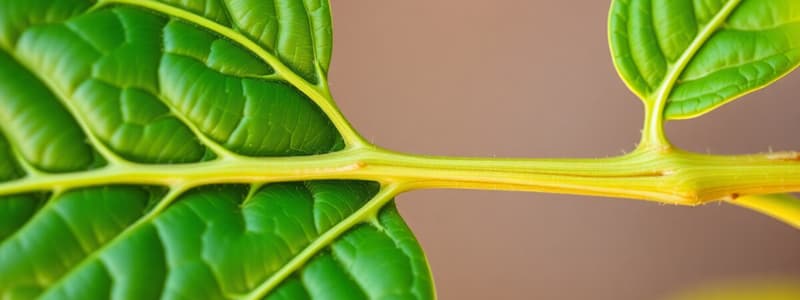Podcast
Questions and Answers
Which of the following is NOT a function of the xylem in plants?
Which of the following is NOT a function of the xylem in plants?
- Transporting water from the roots to the leaves
- Providing structural support to the plant
- Transporting sugars from the leaves to the roots (correct)
- Facilitating the movement of mineral salts from the roots to the leaves
Why is glucose converted to sucrose before being transported in plants?
Why is glucose converted to sucrose before being transported in plants?
- Sucrose is less likely to be used as an energy source by the plant cells during transport.
- The conversion to sucrose allows for a more efficient process of photosynthesis.
- Sucrose is a more stable form of sugar and can travel longer distances. (correct)
- Sucrose is more readily absorbed by root cells.
How does the presence of root hairs contribute to the efficient absorption of water and mineral salts?
How does the presence of root hairs contribute to the efficient absorption of water and mineral salts?
- Root hairs increase the concentration gradient between the soil and root cells, promoting osmosis.
- Root hairs contain specialized enzymes that break down minerals into smaller molecules.
- Root hairs release hormones that stimulate the growth of mineral-absorbing roots.
- Root hairs increase the surface area for absorption, facilitating the uptake of water and minerals. (correct)
Which of the following statements BEST describes the mechanism of water movement from the soil to the xylem vessels?
Which of the following statements BEST describes the mechanism of water movement from the soil to the xylem vessels?
Which of the following statements accurately describes the relationship between xylem, phloem, and vascular tissue?
Which of the following statements accurately describes the relationship between xylem, phloem, and vascular tissue?
Flashcards
Vascular Tissue
Vascular Tissue
Plant tissue specialized for transporting water, minerals, and food.
Xylem Vessels
Xylem Vessels
Transport water and mineral salts from roots to leaves in plants.
Phloem Tissue
Phloem Tissue
Transports glucose (as sucrose) from leaves to the rest of the plant.
Osmosis
Osmosis
Signup and view all the flashcards
Root Hairs
Root Hairs
Signup and view all the flashcards
Study Notes
Plant Transport Systems
- Plants have specialized tissues for transporting water, mineral salts, and food
- Water and mineral salts are transported from roots to leaves via xylem vessels
- Photosynthesis produces glucose; glucose is converted to sucrose for transport
- Sucrose is transported from leaves to other parts of the plant via phloem
- Xylem and phloem form vascular tissue throughout the plant
- Vascular tissue in leaves is called veins
- Root hair cells increase the surface area for water absorption
- Water moves from the soil to the roots through osmosis, driven by a concentration gradient
- Water moves through root cells via osmosis, resulting in root pressure
Studying That Suits You
Use AI to generate personalized quizzes and flashcards to suit your learning preferences.




